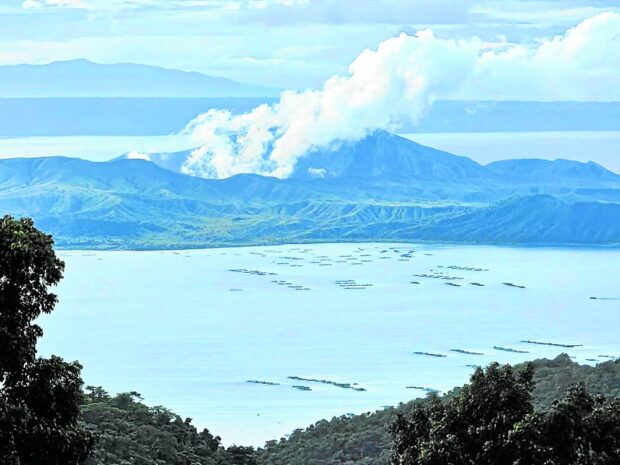Taal Volcano emits high-volume of toxic gas anew

BEAUTY IN A LAKE The scenic view of Taal Volcano from Tagaytay City, Cavite, shown in this photo taken on Oct. 24, portrays calmness amid its continued emission of toxic gas. —MARLON MALLARI/CONTRIBUTOR
LUCENA CITY — Taal Volcano on Monday. Jan. 22, spewed another high volume of volcanic sulfur dioxide, according to the Philippine Institute of Volcanology and Seismology (Phivolcs).
In its bulletin on Tuesday, Phivolcs reported that the volcano emitted 12,591 metric tons (MT) of toxic sulfur dioxide (SO2) over the past 24 hours.
The emission rose to 900 meters above Taal Volcano Island, locally known as “Pulo,” before drifting southwest.
State volcanologists also observed an “upwelling of hot volcanic fluids” in the main crater lake of the volcano on Pulo, which sits in the middle of Taal Lake.
No earthquake was recorded in the latest update.
READ: Phivolcs: Taal Volcano spews high volume of toxic gas again
However, the latest emission level was slightly lower than the 12,685 MT logged on Jan. 4, the highest this year so far.
In 2023, the volcano logged 11,499 MT on Nov. 9, the highest emission level recorded that year.
The high level of SO2 emissions and sporadic steam releases have caused volcanic smog or “vog,” a harmful haze that contains volcanic ash and gas, to descend on localities close to the volcano.
Vog consists of fine droplets containing volcanic gas such as SO2, which is acidic and can cause irritation of the eyes, throat, and respiratory tract, with severities depending on the gas concentrations and durations of exposure.
READ: Taal Volcano’s toxic gas emissions ease
Authorities warned that people, who may be particularly sensitive to vog, are those with health conditions such as asthma, lung disease and heart disease, the elderly, pregnant women, and children.
Local governments were asked to continuously monitor and assess the impact of SO2 and vog on their communities and undertake appropriate response measures to mitigate these hazards.
Taal Volcano remains under alert level 1 (low level of volcanic unrest), according to the state volcanologist.
Phivolcs reminded the public that Taal Volcano remained in an “abnormal condition” and “should not be interpreted to have ceased unrest nor ceased the threat of eruptive activity.”
The Pulo has been off limits to all human activities after the volcano’s major eruption on Jan. 12, 2020. INQ